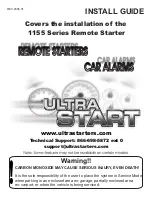
ERGONOMICALLY DESIGNED CASE
The case of the T80 has been designed to give the maximum grip on the box while allowing your fingers freedom and flexibility to control your model
smoothly and safely.
TRIMS
Each of the four (stick controlled) channels has a trimming adjustment alongside the appropriate direction
of motion. These trims give 15 degrees of control authority in each direction to compensate for inaccuracies in the model or local conditions. They shift
the entire range of the channel motion. It is advisable to re-center the trims after each use and make the appropriate modifications to the control surfacs
using the adjustable push-rod clevis. This way the servos are centered instead of being biased off-center. It is important to know that having servos off-
center will cause non-linearity of control motion and should be avoided.
SETTING UP
Plug in the servos, receiver, battery, and switch harness that you plan to use. Check that the switches for the mixing circuits are in the OFF position
before turning on the radio. Turn on the transmitter and then the receiver. The LED battery condition display should illuminate and be green. Please be
aware that the transmitter will be radiating when you turn on. If you are operating you model at a club facility, be sure to observe the frequency control
system in effect at that location and to comply with local procedures for operating your transmitter.
STICK MODE
The stick mode can be changed from 1 to 2 as described below. The stick mode is purely a preferential choice with Mode 2 being the m9ost common
choice in the U.S. Basically, the throttle stick in the U.S. in Mode 2 is on the left and in Mode 1, it's on the right. All compensation is automatically
handled by swapping the elevator and throttle connector cables at the encoder board and the spring for the elevator need be moved to the opposite stick
by removing the back and physically changing the spring and ratchet exactly as they were on the opposite side.
MODULATION/FREQUENCY SHIFT
PPM is the baseline mode for T80. PPM allows for the use of the radio with FM receivers you may own. Your radio will work as a normal 4 or 5-channel
radio. You can use the (shift) DIP switch to select either positive or negative pulse; FMA, Futaba, Hitech, and most receivers work with negative shift
and Airtronics and JR receivers work with a positive shift. FM radio control transmitters have two possible modes of frequency shift keying (FSK). Either
the carrier is set to be nominally 1.5 KHz below the center frequency and shifts 3 KHz upward to be 1.5 KHz above the center frequency when a
modulation pulse is received at the RF deck from the encoder. This is referred to colloquially as "low-going-high" or positive shift. Most R/C transmitters
use negative shift. Two particular brands do not: JR and Airtronics/Sanwa. The latter are "high-going-low". Your T80 transmitter will accommodate
either shift so that T80 can be used with any FM/FSK receiver with PPM decoding. Please be aware that this convention occurs uniformly for the 72MHz
band. It is not always the case for 75MHz.
Select the DIP switch setting that applies to your particular receiver. Do remember to make the change if you shift from one receiver type to the other.
For this, and all functions, it is wise to check for proper operation before each flight/run of your model. While you are at it, be sure the antenna on your
transmitter and receiver are extended. More than one has flown away when the receiver antenna was left coiled up inside the model!
TRI-RATES
P R EP A R A TIO N
C/10 CHARGING INSTRUCTIONS
If your transmitter has alkaline cells, they will operate for many weeks without having to be replaced. Check the LED battery display before each flight/
run and replace alkalines as soon as the display blushes red. Unlike rechargeable cells, alkaline cells do not drop precipitously as they go down in the
manner that NiCd and NiMh cells do. However, output power will reduce and range would be shortened. If your transmitter has the NiCd pack, a spe-
cific C/10 charger is provided with it for the transmitter pack and either a 500 mAh receiver pack. Transmitter and receiver NiCds require a 24-hour
charge when they are first used. After use, they will require an overnight charge (10 to 12 hours) to maintain a fully charged state. Please note that all
NiCd batteries develop a "memory" of discharge level and, if not fully discharged periodically, may refuse to discharge below this level, leading to a
false indication of capacity. It is highly recommended that you acquire an EINSTEIN battery management system for use with all your batteries, R/C or
other to ensure long-life and reliability by controlled discharge to the end of capacity, but not beyond, about once per month. (FMA Direct P/N EINX-
LDEL)
The charger supplied has two display LED's that denote that the receiver batteries and/or the transmitter's batteries are properly connected and charg-
ing.
The charging port for the transmitter is located on the left front of the case. The charger will work only when the transmitter is OFF. When the trans-
mitter is properly plugged into the charger, the appropriate LED will illuminate when the charger is on.
FAST FIELD CHARGING OF BATTERIES
Optionally, FMA Direct produces a fast field charger for T/X, R/X, and electric power packs of batteries. Even if you forgot to charge your batteries
overnight, you may charge them in 20 minutes via our peak detecting method. Several FMA Direct peak-detector fast chargers are available for this
function. You may make a selection of a fast charger that fits this and other uses from our web site at www.fmadirect.com. Read and follow the in-
structions that come with your fast charger before fast charging any battery pack.
O P ER A TIO N






















